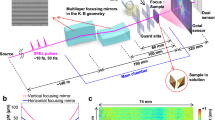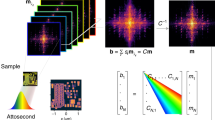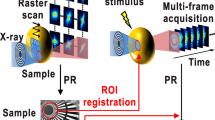Abstract
Our knowledge of the structure of matter is largely based on X-ray diffraction studies of periodic structures and the successful transformation (inversion) of the diffraction patterns into real-space atomic maps. But the determination of non-periodic nanoscale structures by X-rays is much more difficult. Inversion of the measured diffuse X-ray intensity patterns suffers from the intrinsic loss of phase information1,2, and direct imaging methods are limited in resolution by the available X-ray optics3. Here we demonstrate a versatile technique for imaging nanostructures, based on the use of resonantly tuned soft X-rays for scattering contrast and the direct Fourier inversion of a holographically formed interference pattern. Our implementation places the sample behind a lithographically manufactured mask with a micrometre-sized sample aperture and a nanometre-sized hole that defines a reference beam. As an example, we have used the resonant X-ray magnetic circular dichroism effect to image the random magnetic domain structure in a Co/Pt multilayer film with a spatial resolution of 50 nm. Our technique, which is a form of Fourier transform holography, is transferable to a wide variety of specimens, appears scalable to diffraction-limited resolution, and is well suited for ultrafast single-shot imaging with coherent X-ray free-electron laser sources4.
This is a preview of subscription content, access via your institution
Access options
Subscribe to this journal
Receive 51 print issues and online access
$199.00 per year
only $3.90 per issue
Buy this article
- Purchase on Springer Link
- Instant access to full article PDF
Prices may be subject to local taxes which are calculated during checkout



Similar content being viewed by others
References
Stroke, G. W. An Introduction to Coherent Optics and Holography (Academic, New York, 1969)
Miao, J. W., Charalambous, P., Kirz, J. & Sayre, D. Extending the methodology of X-ray crystallography to allow imaging of micrometre-sized non-crystalline specimens. Nature 400, 342–344 (1999)
Chao, W. L. et al. 20-nm-resolution soft x-ray microscopy demonstrated by use of multilayer test structures. Opt. Lett. 28, 2019–2021 (2003)
Neutze, R., Wouts, R., Van der Spoel, D., Weckert, E. & Hajdu, J. Potential for biomolecular imaging with femtosecond X-ray pulses. Nature 406, 752–757 (2000)
Ade, H. & Hsiao, B. X-ray linear dichroism microscopy. Science 262, 1427–1429 (1993)
Stöhr, J. et al. Element-specific magnetic microscopy with circularly polarized X-rays. Science 259, 658–661 (1993)
Fischer, P. et al. Magnetic domain imaging with a transmission X-ray microscope. J. Magn. Magn. Mater. 199, 624–627 (1999)
Gerchberg, R. W. & Saxton, W. O. Practical algorithm for determination of phase from image and diffraction plane pictures. Optik 35, 237–246 (1972)
Fienup, J. R. Phase retrieval algorithms—a comparison. Appl. Opt. 21, 2758–2769 (1982)
Gabor, D., Kock, W. E. & Stroke, G. W. Holography. Science 173, 11–23 (1971)
Focus on X-ray microscopy. Synchrotron Radiat. News (special issue, ed. Schmahl, G.) 16 (3), 2–63 (2003)
Stöhr, J. et al. Element-specific magnetic microscopy with circularly polarized X-rays. Science 259, 658–661 (1993)
Xu, W. B., Jericho, M. H., Meinertzhagen, I. A. & Kreuzer, H. J. Digital in-line holography for biological applications. Proc. Natl Acad. Sci. USA 98, 11301–11305 (2001)
Trebes, J. E. et al. Demonstration of X-ray holography with an X-ray laser. Science 238, 517–519 (1987)
McNulty, I. et al. High-resolution imaging by Fourier-transform X-ray holography. Science 256, 1009–1012 (1992)
Lindaas, S., Howells, H., Jacobsen, C. & Kalinovsky, A. X-ray holographic microscopy by means of photoresist recording and atomic-force microscope readout. J. Opt. Soc. Am. A Opt. Image Sci. Vis. 13, 1788–1800 (1996)
Hannon, J. P., Trammell, G. T., Blume, M. & Gibbs, D. X-ray resonance exchange scattering. Phys. Rev. Lett. 61, 1245–1248 (1988)
Hellwig, O., Denbeaux, G. P., Kortright, J. B. & Fullerton, E. E. X-ray studies of aligned magnetic stripe domains in perpendicular multilayers. Physica B Condens. Matter 336, 136–144 (2003)
Kilcoyne, A. L. D. et al. Interferometer-controlled scanning transmission X-ray microscopes at the Advanced Light Source. J. Synchrotron Radiat. 10, 125–136 (2003)
Stroke, G. W. Lensless Fourier-transform method for optical holography. Appl. Phys. Lett. 6, 201–203 (1965)
Winthrop, J. T. & Worthing, C. R. X-ray microscopy by successive Fourier transformation. Phys. Lett. 15, 124–126 (1965)
Kortright, J. B. et al. Soft-x-ray small-angle scattering as a sensitive probe of magnetic and charge heterogeneity. Phys. Rev. B 64, 92401 (2001)
Eisebitt, S. et al. Polarization effects in coherent scattering from magnetic specimen: Implications for x-ray holography, lensless imaging, and correlation spectroscopy. Phys. Rev. B 68, 104419 (2003)
Bergemann, C., Keymeulen, H. & Van der Veen, J. F. Focusing X-ray beams to nanometer dimensions. Phys. Rev. Lett. 91, 204801 (2003)
Fienup, J. R. Reconstruction of a complex-valued object from the modulus of its Fourier transform using a support constraint. J. Opt. Soc. Am. 4, 118–123 (1987)
Cho, A. The ultimate bright idea. Science 296, 1008–1010 (2002)
Emma, P. et al. Femtosecond and subfemtosecond X-ray pulses from a self-amplified spontaneous-emission–based free-electron laser. Phys. Rev. Lett. 92, 074801 (2004)
Acknowledgements
We thank Y. Acremann for recording the STXM image of the sample at the Advanced Light Source and E. E. Fullerton for access to his thin film deposition facility. The work of the SSRL authors is supported by the US Department of Energy, Office of Basic Energy Sciences.
Author information
Authors and Affiliations
Corresponding authors
Ethics declarations
Competing interests
The authors declare that they have no competing financial interests.
Rights and permissions
About this article
Cite this article
Eisebitt, S., Lüning, J., Schlotter, W. et al. Lensless imaging of magnetic nanostructures by X-ray spectro-holography. Nature 432, 885–888 (2004). https://doi.org/10.1038/nature03139
Received:
Accepted:
Issue Date:
DOI: https://doi.org/10.1038/nature03139
This article is cited by
-
Coherent correlation imaging for resolving fluctuating states of matter
Nature (2023)
-
Probing three-dimensional mesoscopic interfacial structures in a single view using multibeam X-ray coherent surface scattering and holography imaging
Nature Communications (2023)
-
Three-dimensional topological magnetic monopoles and their interactions in a ferromagnetic meta-lattice
Nature Nanotechnology (2023)
-
First commissioning results of the coherent scattering and imaging endstation at the Shanghai soft X-ray free-electron laser facility
Nuclear Science and Techniques (2022)
-
Towards attosecond imaging at the nanoscale using broadband holography-assisted coherent imaging in the extreme ultraviolet
Communications Physics (2021)
Comments
By submitting a comment you agree to abide by our Terms and Community Guidelines. If you find something abusive or that does not comply with our terms or guidelines please flag it as inappropriate.



